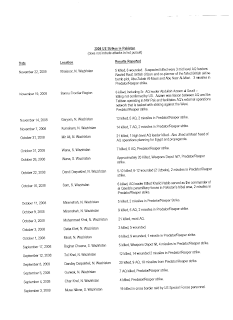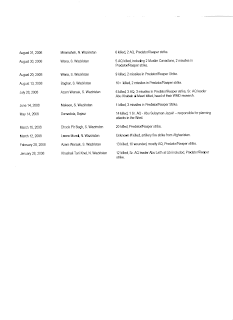The United States has been very actively striking Al Qaeda and Taliban targets in Pakistan this year, especially since the end of July. As of today, there have been thirty-one strikes. Almost all of the strikes have been conducted using Predator and Reaper unmanned aerial vehicles (drones) firing Hellfire missiles.
Almost all of the strikes have been in the wild lawless areas along the border with Afghanistan called the North West Frontier Province (NWFP). While the NWFP is within the borders of Pakistan, the government of Pakistan has never controlled the area or truly exercised sovereignty over the area. The NWFP is made up of an number of areas, some of the largest being North Waziristan and South Waziristan. The Taliban use these areas as bases to plan attacks in Afghanistan. They cross over the mountainous and mostly uncontrolled border into Afghanistan freely and return to find safe haven in Pakistan. In addition, the NWFP is where the #1 and #2 leaders of Al Qaeda (Osama Bin Ladin and Ayman al-Zawahiri) are believed to hide.
Al Qaeda has been regrouping in that area lately. The US government is greatly concerned about the developing threat. In addition to the attacks by NWFP-based Taliban against NATO troops operating in Afghanistan, the US government is very worried that Al Qaeda will plan and launch its next big attack(s) on the West from the NWFP. Consequently, the United States has stepped-up its attacks in the area. The hope is that the attacks will kill some key leaders and disrupt the plans.
Pakistan complains publicly about the attacks. However, the remarkable precision and success of the attacks tells me that the Pakistani government actually supports the attacks and provides much of the intelligence for the strikes. There is no way that the US could have such precise success relying solely on our own intelligence information. The Pakistani complaints are simply designed to placate their population (after all they are essentially calling-in air strikes on their own territory).
Below are two documents that list the dates of the strikes (starting with the most recent), the location of the strikes, and the results of the strikes. Most of this information comes from the the Long War Journal (LWJ). LWJ is an invaluable source of information regarding the War on Terror. It is a not-for-profit website that is not affiliated with the main stream media. Its editor is a former US Army service person who left his business job several years after 9/11 to devote his efforts to writing about the war. He can always use donations from readers to help fund his good work. Donations are tax deductible.
Almost all of the strikes have been in the wild lawless areas along the border with Afghanistan called the North West Frontier Province (NWFP). While the NWFP is within the borders of Pakistan, the government of Pakistan has never controlled the area or truly exercised sovereignty over the area. The NWFP is made up of an number of areas, some of the largest being North Waziristan and South Waziristan. The Taliban use these areas as bases to plan attacks in Afghanistan. They cross over the mountainous and mostly uncontrolled border into Afghanistan freely and return to find safe haven in Pakistan. In addition, the NWFP is where the #1 and #2 leaders of Al Qaeda (Osama Bin Ladin and Ayman al-Zawahiri) are believed to hide.
Al Qaeda has been regrouping in that area lately. The US government is greatly concerned about the developing threat. In addition to the attacks by NWFP-based Taliban against NATO troops operating in Afghanistan, the US government is very worried that Al Qaeda will plan and launch its next big attack(s) on the West from the NWFP. Consequently, the United States has stepped-up its attacks in the area. The hope is that the attacks will kill some key leaders and disrupt the plans.
Pakistan complains publicly about the attacks. However, the remarkable precision and success of the attacks tells me that the Pakistani government actually supports the attacks and provides much of the intelligence for the strikes. There is no way that the US could have such precise success relying solely on our own intelligence information. The Pakistani complaints are simply designed to placate their population (after all they are essentially calling-in air strikes on their own territory).
Below are two documents that list the dates of the strikes (starting with the most recent), the location of the strikes, and the results of the strikes. Most of this information comes from the the Long War Journal (LWJ). LWJ is an invaluable source of information regarding the War on Terror. It is a not-for-profit website that is not affiliated with the main stream media. Its editor is a former US Army service person who left his business job several years after 9/11 to devote his efforts to writing about the war. He can always use donations from readers to help fund his good work. Donations are tax deductible.

